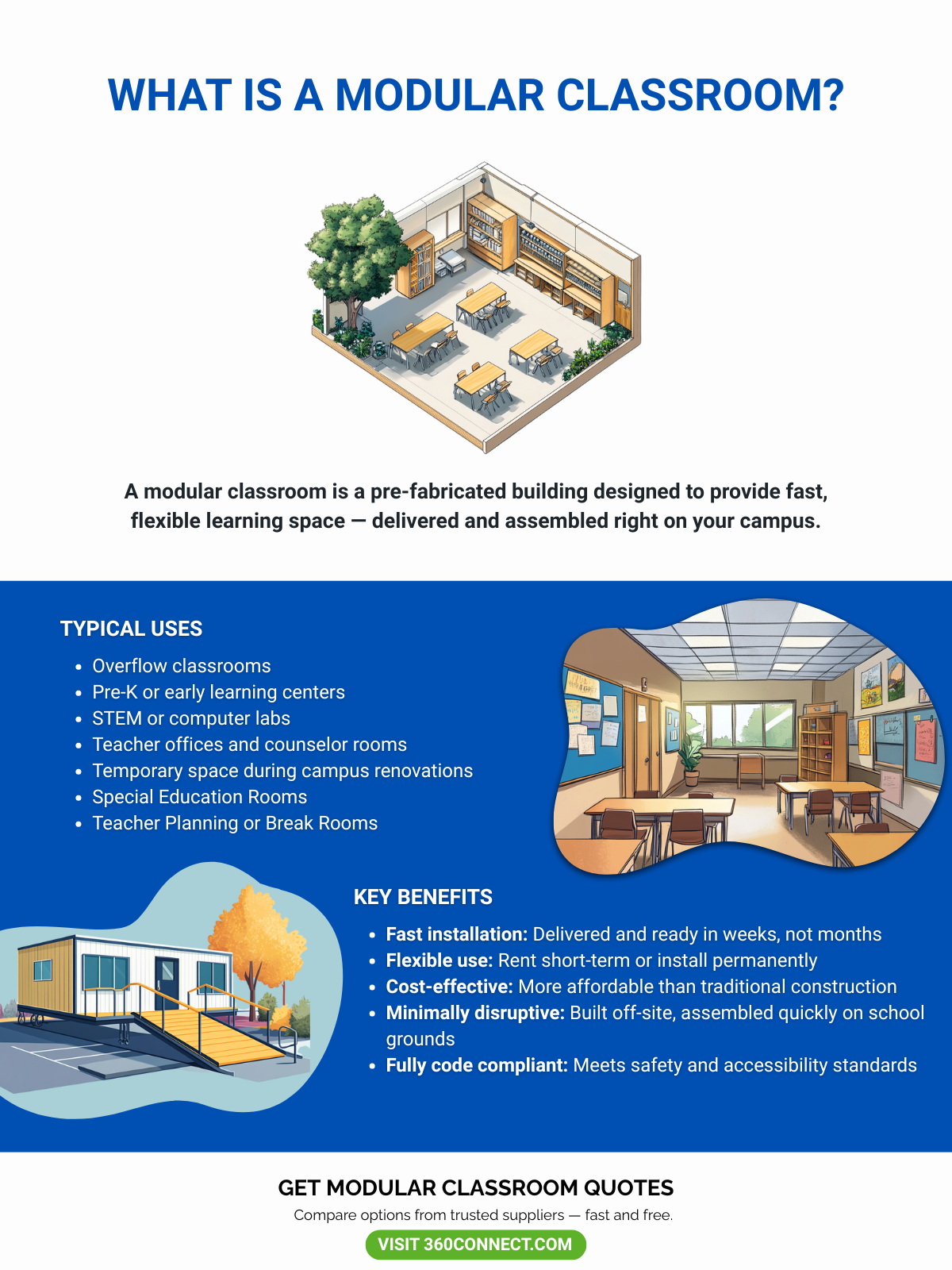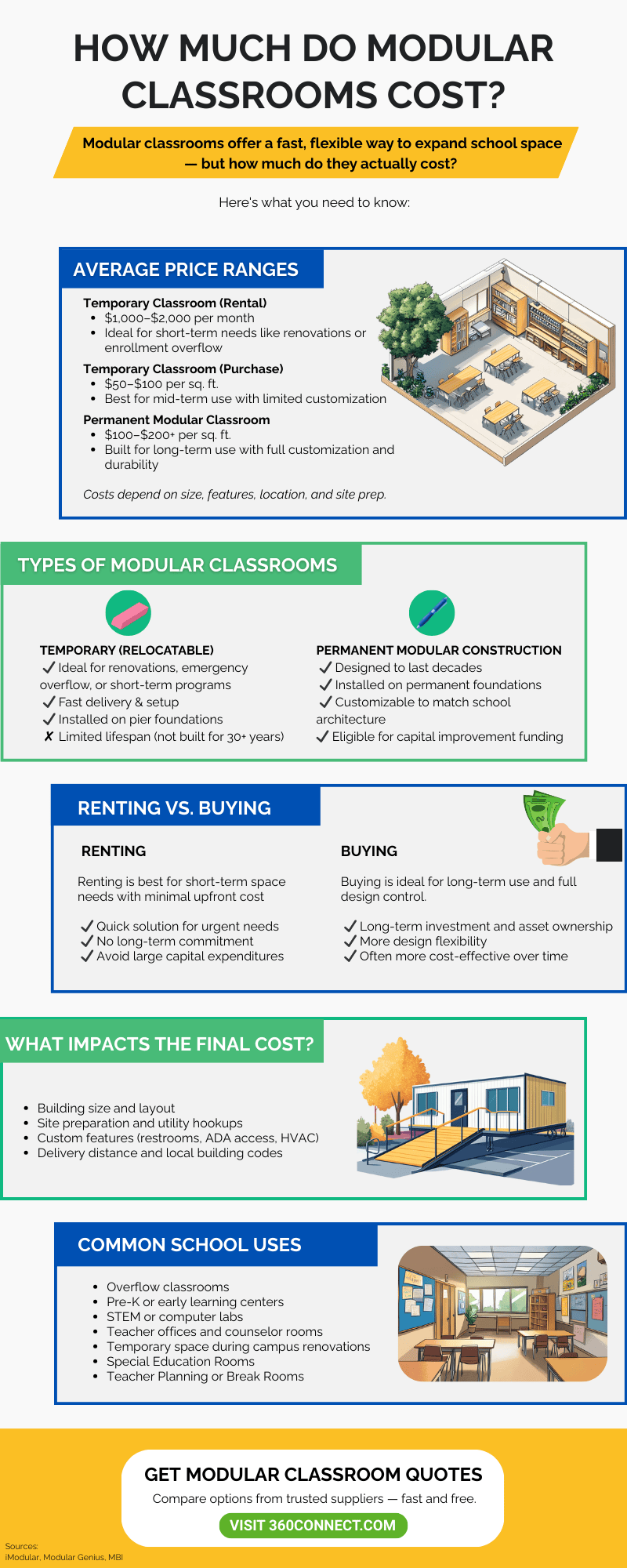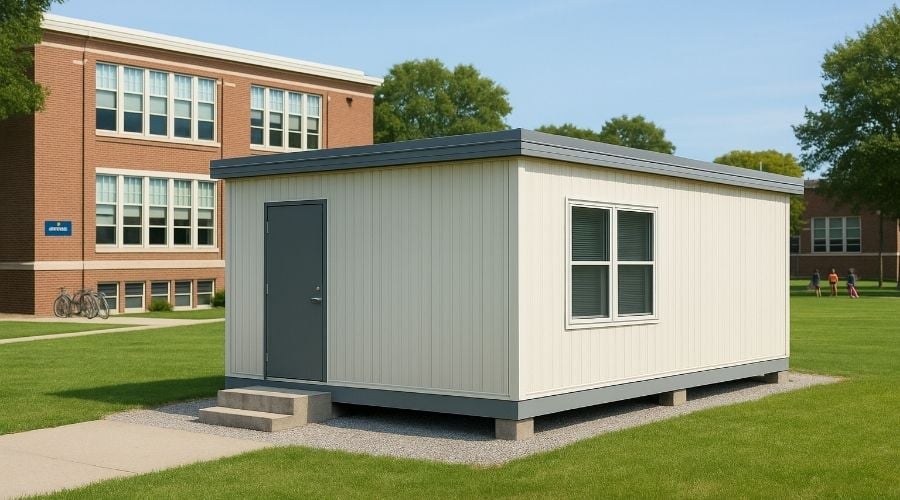As schools grow and classroom space becomes harder to come by, many districts are looking for quick, cost-effective alternatives to traditional construction. One of the most popular solutions? Modular classrooms.
But before you invest, you’re likely wondering: How much do modular classrooms cost?
The answer depends on a few important factors — like the size of the building, how it’s used, whether you rent or buy, and how much site work is needed. We’ll cover all of that in this guide.
So, whether you need space for one class or a full wing of students, let’s break down the numbers, compare your options, and get clear on what really drives cost.
Related: What is a Modular Building
What Is a Modular Classroom?
A modular classroom is a prefabricated building designed to serve as a learning space. Instead of being built entirely on-site like traditional buildings, modular classrooms are constructed off-site in a factory and delivered to the school in sections (or “modules”) for quick installation.
They can be used temporarily or permanently and are often chosen by schools that need to expand space quickly, affordably, and with minimal disruption.

Average Cost of Modular Classrooms
Now that we’ve covered what modular classrooms are, let’s get into what school leaders really want to know: how much do they cost?
Whether you’re considering a temporary rental or a long-term investment, modular classroom pricing can vary depending on size, features, and setup requirements.
Here’s a general price breakdown to give you a starting point:
| Type | Estimated Cost |
| Temporary Classroom (Rental) | $1,000 – $2,000/month per unit |
| Temporary Classroom (Purchase) | $50 – $100 per sq. ft. |
| Permanent Modular Classroom | $100 – $200+ per sq. ft. |

Types of Modular Classrooms: Temporary vs. Permanent
Okay, now that you’ve seen the pricing ranges, you might be wondering: What’s the difference between a $50/sq. ft. building and one that costs $200/sq. ft.? The answer starts with understanding the type of modular classroom you choose.
There are two main types: temporary (also called relocatable) and permanent modular classrooms. And yes — the type impacts the price in a big way.
Temporary (Relocatable) Modular Classrooms
These are ideal when you need space quickly and for a limited time. They’re typically installed on pier foundations and are faster and cheaper to deploy. Schools often rent or purchase these when they’re undergoing construction, responding to an enrollment spike, or waiting on long-term funding.
Relocatable classrooms are generally more affordable up front, but they come with limited customization and aren’t designed to last for decades. That said, we know plenty of schools that planned to use them “just for now” — and 10 years later, they’re still going strong.
Permanent Modular Classrooms
These buildings are built for the long haul — literally. They’re placed on full foundations, made from more durable materials, and meet the same codes as traditional buildings. They’re also more customizable and can be designed to match your existing campus.
Because of the added construction and lifespan, permanent modular classrooms cost more — but if you plan to use them for 20–30 years, they offer better long-term value.
Renting vs. Buying a Modular Classroom
Now that you know the two main types of modular classrooms, the next big decision is this:
Should your school rent or buy?
This question matters because it directly impacts your total cost — both upfront and long-term. Whether you’re working with limited funds or planning for permanent expansion. Understanding the differences between renting and buying can help you budget smarter and avoid surprises.
Let’s break down what each option involves and what you can expect to pay.
Renting a Modular Classroom
Renting is ideal if you need space fast — but only for a limited time. Maybe your main building is under renovation, or you’re navigating a sudden enrollment surge. Renting gives you the flexibility to bring in extra classrooms without the long-term financial commitment.
Typically, rented modular classrooms are prebuilt and ready to ship. So they can be delivered and installed in just a few weeks. You’ll sign a lease for 12 to 60 months (or more), and the provider usually handles maintenance during that time. When you’re finished with it, the unit is picked up and removed — no strings attached.
This option helps schools avoid large upfront investments, especially when there’s uncertainty around future needs or funding. However, if you rent for several years, the cost can add up — so it’s worth comparing rental totals to ownership costs.
Cost to Rent a Modular Classroom
A standard 24′ x 40′ modular classroom typically rents for $1,000 to $2,000 per month, depending on your region, lease length, and any extra features. Most providers charge separately for delivery, setup, and removal. While it may seem low-cost at first, it’s important to calculate the full cost over the length of your lease.
Buying a Modular Classroom
Buying is the better fit when your school needs space long-term. If you’re planning a permanent expansion, adding new grade levels, or growing your campus footprint, owning your modular classroom gives you more control and more value over time.
When you buy, you get to choose the layout, finishes, and placement — and permanent modular buildings are designed to last 30+ years. They’re often treated as capital assets, meaning your district can amortize the cost and gain equity in the building over time.
Buying also allows you to align the building’s look and function with the rest of your campus, whether that means matching brickwork or building out a full modular wing.
Cost to Buy a Modular Classroom
Permanent modular classrooms usually cost $100 to $200+ per square foot depending on design, materials, and how much site prep is required. A 960 sq. ft. classroom could run $96,000 to $192,000 or more — not including foundation work, utility hookups, or permits. While it’s a larger investment up front, it often saves money over decades of use.
What Impacts the Cost of Modular Classrooms?
At this point, you’ve seen the price ranges — but you’re probably wondering: Why such a wide gap in cost? What exactly am I paying for?
Modular classroom pricing isn’t one-size-fits-all. Your final number depends on more than just square footage. From the type of foundation to the features inside the building, a variety of factors influence how much you’ll spend.
Let’s break down the biggest cost drivers so you know exactly what to look out for when getting quotes.
1. Size and Layout
This one’s simple: bigger buildings cost more. But size isn’t the only thing that matters — layout plays a huge role too.
A basic 24’ x 40’ single-room classroom is one of the most affordable options. But as soon as you start adding interior walls, restrooms, teacher offices, or specialty zones like labs or testing rooms, the cost per square foot goes up.
Custom layouts = custom pricing. So if your school has specific program needs, make sure your budget reflects the complexity of the design — not just the dimensions.
2. Temporary vs. Permanent
We covered the differences earlier, but it’s worth repeating: whether your modular classroom is temporary or permanent will significantly affect cost.
Temporary modular classrooms are cheaper upfront and faster to install, but they’re not built to last more than a few years. These are the classrooms most often rented.
Permanent modular classrooms require site prep, foundations, and more durable materials — but they’re built to last decades. They cost more per square foot, but the value pays off if the space is needed long-term.
So when asking, “How much will this cost?” — always clarify what kind of build you’re pricing.
3. Customization and Features
Want built-in storage, specialty lighting, or smartboards? Every feature you add will affect cost. Basic modular classrooms come with essentials — HVAC, basic electrical, lighting, and insulation — but if you want to elevate the space, your budget should reflect that.
Also, don’t forget accessibility. Features like ADA-compliant ramps, wide doorways, and handrails are legally required and often add cost (especially if they require more space or special materials).
If you need tech-ready rooms or custom IT setups, plan for additional wiring, ports, and electrical capacity, which may bump up your estimate.
4. Site Preparation
Even if your modular classroom is prebuilt, the site it goes on still needs work — and that work costs money.
Site prep includes grading the land, running utility lines, laying the foundation (or piers), adding ramps or steps, and ensuring code compliance. Depending on your location, this can cost anywhere from $10,000 to $50,000+.
Things like difficult terrain, urban limitations, or tight delivery access may increase the time and equipment needed to get your building in place.
5. Location and Delivery
Modular buildings are shipped from regional factories, and transportation isn’t free. The farther you are from a supplier — or the more equipment needed to install the unit — the more you’ll pay.
Also, local regulations can affect material and labor costs. Some areas may require union workers or additional weatherproofing features (like in hurricane zones), both of which will impact pricing.
So if you see wildly different quotes for the same square footage, geography and permitting could be the reason why.
Typical Use Cases and Space Requirements
So far we’ve focused on what modular classrooms cost — but what are schools actually using them for?
The great thing about modular classrooms is that they’re incredibly versatile. And knowing how you’ll use the space helps you better estimate what features and size you’ll need (aka, how much it will cost).
Here are the most common use cases:
Overflow Classrooms
When enrollment jumps unexpectedly, modular classrooms help schools avoid overcrowding and keep class sizes reasonable. One to three extra units can be installed quickly to ease pressure on the main building.
Specialized Learning Areas
Need a science lab, art studio, or music room? Modular buildings can be built to spec for specialty programs — giving students access to more hands-on learning without waiting for new construction.
Early Childhood or Pre-K Centers
These younger learning environments need age-specific features like low sinks, nap zones, and soft flooring. Modular classrooms can be tailored for early learners and deployed quickly as programs expand.
Administrative or Counseling Offices
It’s not always about student space. Many schools use modular units for teacher planning rooms, counselor offices, or special education meeting rooms when there’s no more room in the main facility.
Temporary Space During Construction
If your campus is being renovated, modular classrooms let you keep students on-site instead of relocating them. It’s a temporary fix that doesn’t sacrifice continuity.
Benefits of Modular Classrooms
Alright, by now we’ve talked about the costs, the types, and what affects the price — but you might still be wondering:
“Is this actually worth the investment?”
Good question. Modular classrooms don’t just save money — they come with a long list of benefits that make them an attractive choice for schools needing space now (and later). Let’s walk through why so many districts are choosing modular over traditional construction.
1. Faster Turnaround Time
Let’s face it — traditional school construction can drag on. From planning and permitting to weather delays and inspections, a new building can take 12–24 months to complete.
Modular classrooms? A different story.
Because these buildings are constructed off-site while the foundation is being prepped, delivery and installation can often be completed in just 6–12 weeks. That’s a huge difference — especially if you’re trying to get students into new classrooms before the next school year starts.
For schools facing urgent space needs, fast installation isn’t just convenient — it’s critical. A modular classroom can be the difference between squeezing 30 kids into a tight room or giving them a dedicated space to learn comfortably.
2. Lower Total Costs
Let’s bring it back to the big question: How much do modular classrooms cost — and are they really cheaper?
In many cases, yes. According to McKinsey & Company, modular construction can lower overall building costs by up to 20%, thanks to more efficient labor, less waste, and shorter timelines.
Plus, renting a classroom for $1,000–$2,000/month can help schools meet immediate needs without dipping into capital funds or going through a lengthy bond approval process. It’s especially useful when space is needed fast, and long-term plans are still taking shape.
And with many providers bundling services like delivery, setup, maintenance, and removal, modular classrooms help simplify your budget — and your to-do list.
3. Flexibility and Scalability
One of the biggest perks of modular classrooms? You can expand on your own terms.
Start with one unit this year, add another next year — no need to commit to a massive construction project all at once. Modular designs can be scaled up, rearranged, or even moved to another campus if needed.
And it’s not just about adding more units. Permanent modular buildings can be configured to match your long-term layout goals, complete with hallways, restrooms, and shared spaces.
Whether you’re adjusting to new grade levels, launching specialized programs, or building out a new wing entirely, modular gives you the flexibility to grow without overcommitting.
4. Minimal Disruption to School Operations
Ask any principal what the worst part of campus construction is, and they’ll probably say: the noise, the mess, and the impact on the school day.
With modular classrooms, that’s rarely a problem. Since the bulk of the work happens off-site, your school avoids months of noise, debris, and safety risks — which means students and staff can stay focused on learning.
Most on-site work (like installing the building and connecting utilities) is done quickly — sometimes over weekends or breaks — so class isn’t interrupted. It’s a cleaner, safer, and more controlled process that fits into the rhythm of the school year.
5. Code Compliance and Quality Assurance
Let’s clear this up: modular doesn’t mean lower quality. In fact, modular classrooms are built to meet or exceed the same state and local codes as traditional school buildings — including structural safety, fire protection, and ADA accessibility.
Because they’re assembled in a factory, these classrooms benefit from tighter quality control. Each part is constructed under strict supervision, with fewer delays and less risk of weather-related damage.
And since they have to hold up during transportation and installation, modular buildings are often built with reinforced framing and more durable materials. Many also come with energy-efficient features and extended warranties to give schools peace of mind for the long haul.
6. Sustainability and Environmental Impact
More schools are making sustainability a priority — and modular classrooms can support those goals, too.
Because the construction process happens in a factory setting, modular buildings produce significantly less material waste than traditional construction. Materials are used more efficiently, and leftovers are often recycled instead of tossed.
Modular classrooms also support green design. Features like energy-efficient HVAC systems, enhanced insulation, and low-VOC paints can be built into your design from the start. And when the building is no longer needed, it doesn’t go to waste — many modular units can be relocated, repurposed, or reused on another site.
The bottom line? Modular classrooms aren’t just fast and affordable — they’re smart for the environment, too.
Final Thoughts
At the end of the day, modular classrooms give schools a faster, more flexible, and more affordable way to grow. Whether you need a temporary solution during construction or a permanent addition to your campus, there’s a modular option that fits your timeline and your budget.
Understanding how size, features, installation, and location affect pricing will help you make a confident, informed decision — and avoid hidden costs down the road.
Find the Right Modular Classroom for Your School
360Connect connects schools with modular classroom suppliers. Get up to 5 free quotes and compare your options today.

